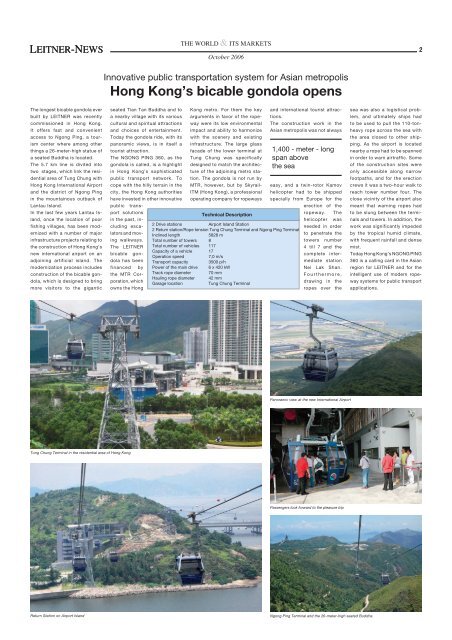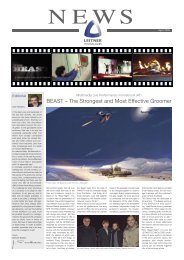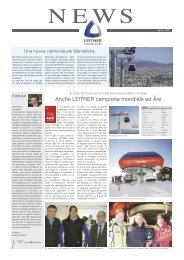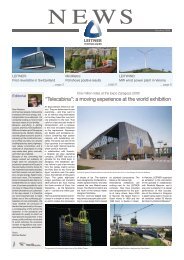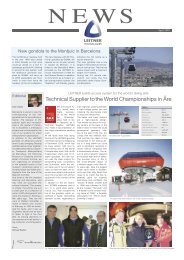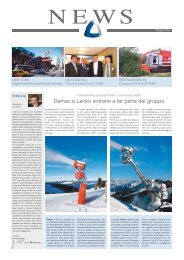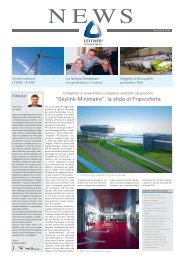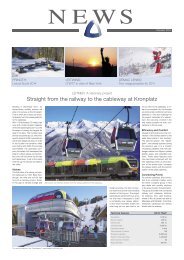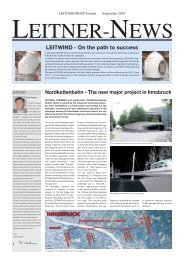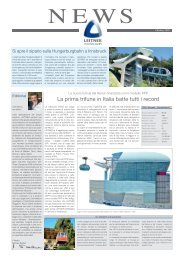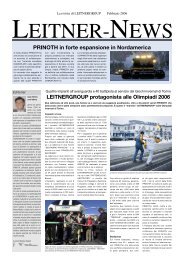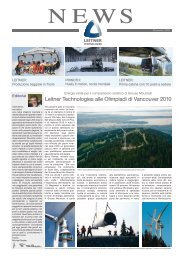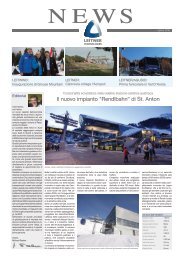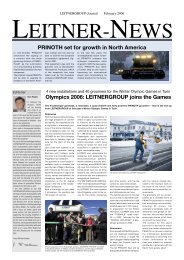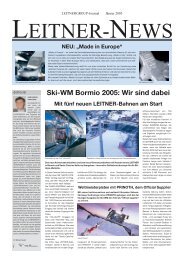11_Leitner News.indd - Leitner Ropeways
11_Leitner News.indd - Leitner Ropeways
11_Leitner News.indd - Leitner Ropeways
You also want an ePaper? Increase the reach of your titles
YUMPU automatically turns print PDFs into web optimized ePapers that Google loves.
THE WORLD & ITS MARKETS<br />
LEITNER-NEWS<br />
2<br />
October 2006<br />
Innovative public transportation system for Asian metropolis<br />
Hong Kong’s bicable gondola opens<br />
The longest bicable gondola ever<br />
built by LEITNER was recently<br />
commissioned in Hong Kong.<br />
It offers fast and conv enient<br />
access to Ngong Ping, a tourism<br />
center where among other<br />
things a 26-meter-high statue of<br />
a seated Buddha is located.<br />
The 5.7 km line is divited into<br />
two stages, which link the residential<br />
area of Tung Chung with<br />
Hong Kong International Airport<br />
and the district of Ngong Ping<br />
in the mountainous outback of<br />
Lantau Island.<br />
In the last few years Lantau Island,<br />
once the location of poor<br />
fishing villages, has been modernized<br />
with a number of major<br />
infrastructure projects relating to<br />
the construction of Hong Kong’s<br />
new international airport on an<br />
adjoining artificial island. The<br />
modernization process includes<br />
construction of the bicable gondola,<br />
which is designed to bring<br />
more visitors to the gigantic<br />
seated Tian Tan Buddha and to<br />
a nearby village with its various<br />
cultural and spiritual attractions<br />
and choices of entertainment.<br />
Today the gondola ride, with its<br />
Kong metro. For them the key<br />
arguments in favor of the ropeway<br />
were its low environmental<br />
impact and ability to harmonize<br />
with the scenery and existing<br />
and international tourist attractions.<br />
The construction work in the<br />
Asian metropolis was not always<br />
panoramic views, is in itself a infrastructure. The large glass<br />
tourist attraction.<br />
facade of the lower terminal at 1,400 - meter - long<br />
The NGONG PING 360, as the<br />
gondola is called, is a highlight<br />
in Hong Kong’s sophisticated<br />
public transport network. To<br />
cope with the hilly terrain in the<br />
city, the Hong Kong authorities<br />
have invested in other innovative<br />
Tung Chung was specifically<br />
designed to match the architecture<br />
of the adjoining metro station.<br />
The gondola is not run by<br />
MTR, however, but by Skyrail-<br />
ITM (Hong Kong), a professional<br />
operating company for ropeways<br />
span above<br />
the sea<br />
easy, and a twin-rotor Kamov<br />
helicopter had to be shipped<br />
specially from Europe for the<br />
public transport<br />
erection of the<br />
solutions<br />
in the past, including<br />
Technical Description<br />
ropeway.<br />
helicopter<br />
The<br />
was<br />
esca-<br />
2 Drive stations Airport Island Station<br />
needed in order<br />
2 Return station/Rope tension Tung Chung Terminal and Ngong Ping Terminal<br />
lators and moving<br />
Inclined length<br />
5828 m<br />
to penetrate the<br />
walkways. Total number of towers 8<br />
towers number<br />
The LEITNER Total number of vehicles <strong>11</strong>7<br />
4 till 7 and the<br />
Capacity of a vehicle 17<br />
bicable gondola<br />
has been Transport capacity 3500 p/h<br />
mediate station<br />
complete inter-<br />
Operation speed<br />
7,0 m/s<br />
financed by Power of the main drive 6 x 420 kW<br />
Nei Lak Shan.<br />
the MTR Corporation,<br />
which<br />
drawing in the<br />
Track rope diameter 70 mm<br />
Fourthermore,<br />
Hauling rope diameter 42 mm<br />
Garage location<br />
Tung Chung Terminal<br />
owns the Hong<br />
ropes over the<br />
sea was also a logistical problem,<br />
and ultimately ships had<br />
to be used to pull the <strong>11</strong>0-tonheavy<br />
rope across the sea with<br />
the area closed to other shipping.<br />
As the airport is located<br />
nearby a rope had to be spanned<br />
in order to warn airtraffic. Some<br />
of the construction sites were<br />
only accessible along narrow<br />
footpaths, and for the erection<br />
crews it was a two-hour walk to<br />
reach tower number four. The<br />
close vicinity of the airport also<br />
meant that warning ropes had<br />
to be slung between the terminals<br />
and towers. In addition, the<br />
work was significantly impeded<br />
by the tropical humid climate,<br />
with frequent rainfall and dense<br />
mist.<br />
Today Hong Kong’s NGONG PING<br />
360 is a calling card in the Asian<br />
region for LEITNER and for the<br />
intelligent use of modern ropeway<br />
systems for public transport<br />
applications.<br />
Panoramic view at the new International Airport<br />
Tung Chung Terminal in the residential area of Hong Kong<br />
Passengers look forward to the pleasure trip<br />
Return Station on Airport Island<br />
Ngong Ping Terminal and the 26-meter-high seated Buddha


